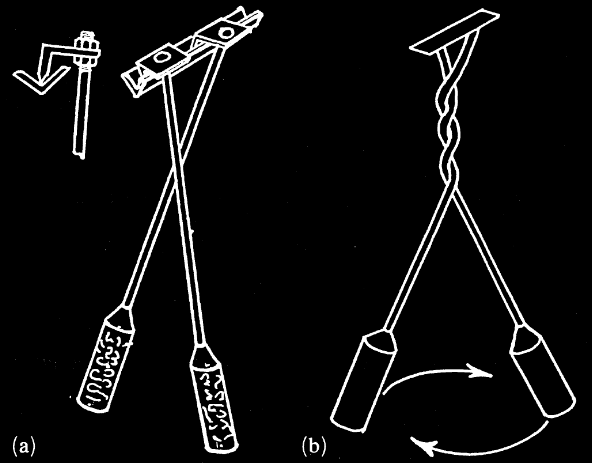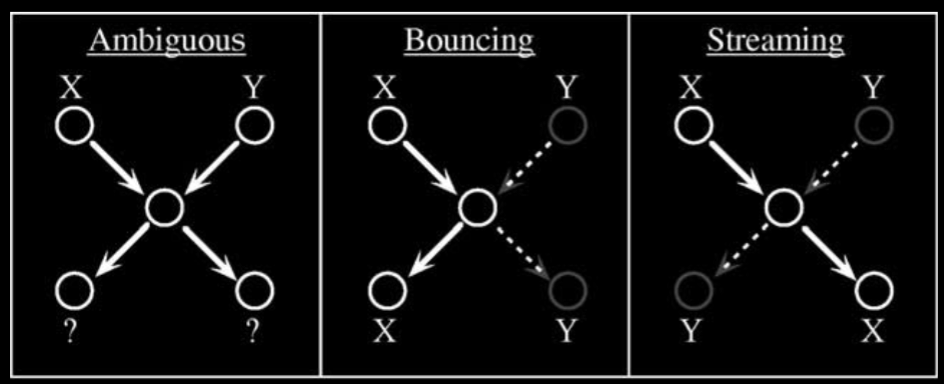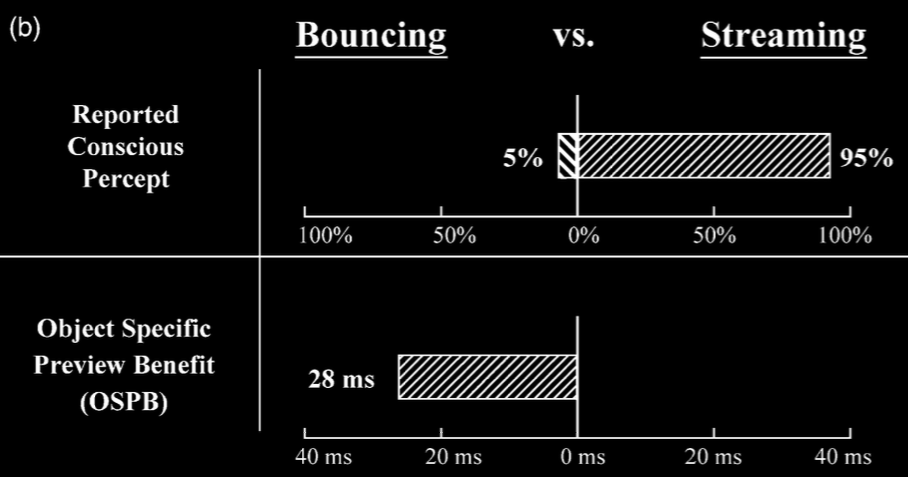Click here and press the right key for the next slide (or swipe left)
also ...
Press the left key to go backwards (or swipe right)
Press n to toggle whether notes are shown (or add '?notes' to the url before the #)
Press m or double tap to slide thumbnails (menu)
Press ? at any time to show the keyboard shortcuts
Appendix: The Pulfrich Double Pendulum Illusion

Wilson & Robinson 1986, figure 1
The Pulfrich double pendulum illusion \citep{wilson:1986_impossibly}.
figure caption: ‘The double Pulfrich pendulum: (a) construction of the
pendulums; (b) what observers do not see. The pendulums are set swinging in
opposite phase and observed with both eyes, one eye covered by a neutral
density filter ( ~ 2 log units). Observers see the pendulum bobs following
each other round in a horizontal ellipse. They do not see the arms twist
round each other as they should if the seen movements of the bobs were
veridical. Observers are disconcerted by this inconsistency.’
LESLIE: ‘What Wilson and Robinson do not describe, however, is what observers
see happening to the rods. They say that observers do not see them twisting
round each other, but they do not say what observers do see.’
‘I have therefore investigated this myself ... Equally striking is the clear
perception of the rigid solid rods passing through each other. Most observers
were able to find an angle of view where even the pendulum bottles appear to
pass through one another despite their large size and marked surface texture.’
\citep[pp.~198--9]{Leslie:1988ct}
Note that there is a dearth of information about whether assigning and
maintaining object indexes really does take into account solidity.

Mitroff, Scholl and Wynn 2005, figure 2
Compare Scholl and Mitroff’s bouncing/streaming study. This study:
(i) suggests solidity may be a constraint, at least sometimes;
(ii) indicates that phenomenology and object indexes may not perfectly align
Mitroff et al p. 74: ‘we induced a strong bias to consciously perceive
streaming, by using smooth, constant, and reasonably fast motion. This
allows us to provide the clearest possible situation in which to evaluate
the relationship between conscious percepts and object files.’
Note that:
The claim that some system of object indexes sometimes gives rise to
phenomenal expectations does not imply that object indexes and phenomenal
expectations are always aligned. Mitroff et al. (2005) construct a situation
involving two objects which simultaneously undergo temporary occlusion. In
this situation, perceivers’ verbal reports imply the objects’ paths crossed
whereas measuring an object-specific preview benefit implies that the objects
bounced off each other. The object indexes underpinning object-specific
preview benefits are unlikely to be informing phenomenal expectations about
objects’ movements in this situation. Object indexes and phenomenal
expectations can come apart in some situations.

Mitroff, Scholl and Wynn 2005, figure 3
Return to the claims and Rips’ objection ...
‘object perception reflects basic constraints on the motions of physical bodies …’
(Spelke 1990: 51)
\citep[p.\ 51]{Spelke:1990jn}
‘A single system of knowledge … appears to underlie object perception and physical reasoning’
\citep[p.\ 175]{Carey:1994bh}
(Carey and Spelke 1994: 175)
I think there's something here that should be uncontroversial, and
something that's more controversial.
Rips’ objection (2011, p. 92)
Leslie’s informal report on the Pulfrich double pendulum illusion (which
appears never to have been published) suffices to show that
it was too simple to say that
‘object perception and causal perception are one and the same process’ or to
talk about ‘object perception and physical reasoning’.
But it remains possible that the launching effects are consequences of the
ways that object indexes are assigned and maintained (although this is far
from the only conclusion compatible with the limited available evidence).
Rips: ‘This possibility, though, is not one that advocates of Michotte’s
hypothesis have taken up. The favored view is one in which separate
modules are responsible for descriptions of objects and of their
mechanical interactions, with central mechanisms then resolving potential
conflicts between them.
For example, Leslie (1988) argues that perceptual
modules do not by themselves settle inconsistencies between the spatial
positions of objects and their causal interactions. In certain
illusions, adults tend to perceive solid objects passing through each other
(Leslie cites the Pulfrich double-pendulum illusion; see Wilson &
Robinson, 1986). Thus, the module for object tracking doesn’t prohibit
interpretations of physical events that are causally impossible. Of
course, people realize that such events cannot really be taking place and
are surprised when they perceive them, but that is because they have
principles stored in long-term memory—for example, the principle that two
solid objects cannot be in the same place at the same time—that classify
these events as illusions or anomalies. Leslie’s argument suggests
that people individuate objects and calculate their causal relations by
means of separate mechanisms; thus, we can’t count on causal constraints
being part of the object-tracking module. If Leslie is right, there is
reason to question Butterfill’s (2009) conjecture that ‘object
perception and causal perception are one and the same process’’ (p.
421).’